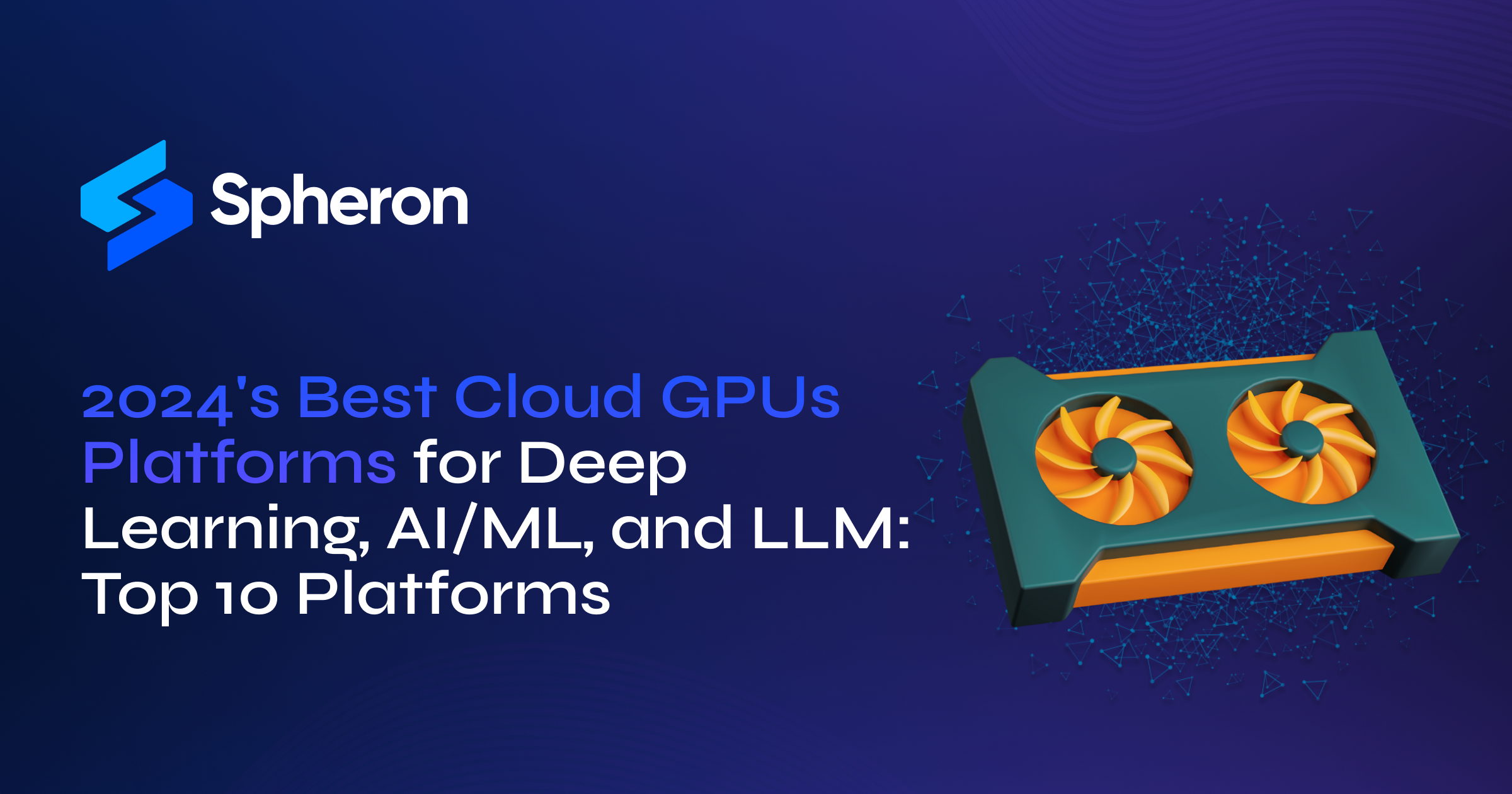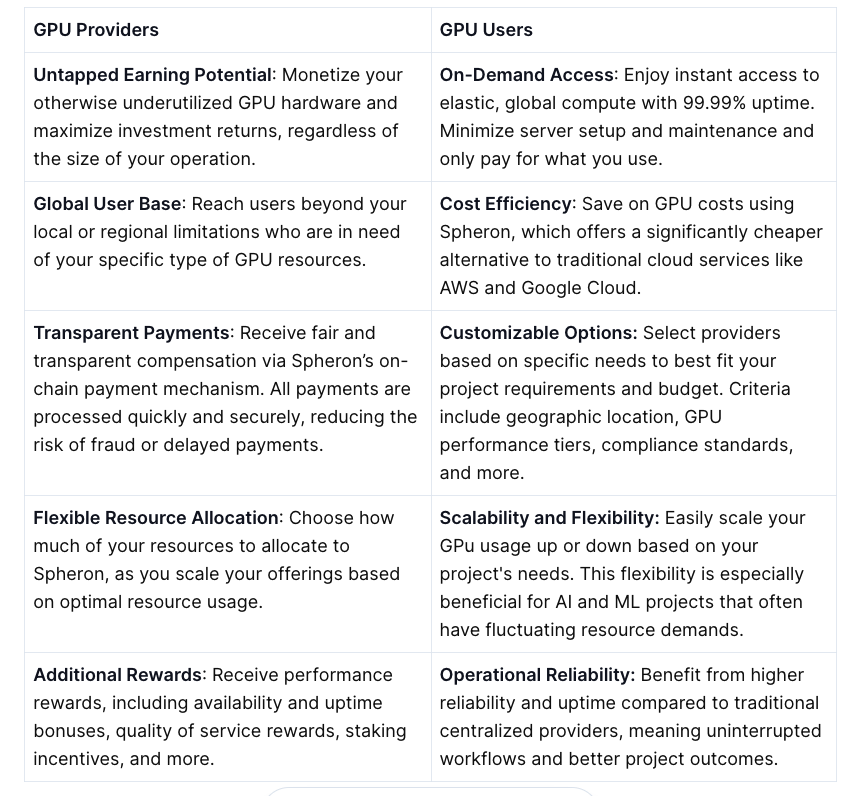2024's Best Cloud GPUs Platforms for Deep Learning, AI/ML, and LLM: Top 10 Platforms
 Spheron Network
Spheron Network
Deep Learning, AI/ML, and LLM have revolutionized various industries, but the computational requirements for training and inference often pose a significant challenge. Cloud GPU platforms provide researchers and developers with scalable and cost-effective access to high-performance computing resources crucial for deep learning projects. By eliminating the need for substantial hardware investments, these platforms democratize access to advanced technology, making high-performance computing accessible.
In this article, we rank the top 10 cloud GPU platforms designed for deep learning. Our evaluation considers multiple factors: availability, pricing structures, unique features they manifest, and suitability for specific use cases. By examining each platform's strengths and weaknesses, we aim to help you make an informed decision that best meets your deep learning needs.
Criteria for Evaluating Cloud GPU Platforms
Selecting the appropriate cloud GPU platform for Deep Learning, AI/ML, and LLM projects is a crucial decision impacting the success of research, development, and deployment. To help you make an informed choice, we have outlined essential criteria for evaluating the top ten platforms:
Software and Ecosystem
Deep Learning Frameworks: Pre-installed support for popular frameworks like TensorFlow and PyTorch for smooth development.
Machine Images: Pre-built images with optimized software configurations for quick deployment.
Integration with Other Services: Integration with other cloud services for comprehensive workflows.
Ease of Use
User Interface: The intuitiveness and user-friendliness of the platform’s dashboard or interface.
API: Availability of a well-documented API
Documentation and Tutorials: Comprehensive resources to assist users in getting started and troubleshooting issues.
Hardware Availability
GPU Options: The range and availability of GPU models to meet varying performance and budget needs.
vCPU and RAM Configurations: Flexibility in selecting CPU and memory resources to suit specific workload demands.
Networking: The speed and reliability of the network infrastructure for efficient data transfer and communication.
Benchmark Results: Performance comparisons on standard deep learning tasks (e.g., image classification, natural language processing) to assess real-world effectiveness.
Pricing Structures
On-Demand Pricing: Hourly costs for different GPU instances, allowing for flexible usage and scalability.
Spot Instances: Spot instances are available at potentially lower costs, which is ideal for fault-tolerant workloads.
Preemptible Instances: Cost-saving options similar to spot instances but with potential interruptions by the provider.
Customer Support
Responsiveness: The availability and responsiveness of customer support channels (e.g., email, phone, chat).
Expertise: The knowledge and expertise of support staff in addressing deep learning-specific issues.
Additional Features
Monitoring and Logging: Tools for tracking resource usage, performance, and troubleshooting errors.
Security: Robust security measures to protect data and intellectual property.
Whether your priority is hardware availability, cost-effectiveness, ease of use, or specific features, this comprehensive evaluation will guide you to the best solution for your project. Let’s delve into the individual assessments of each of the top ten cloud GPU platforms, highlighting their strengths and weaknesses.
1. Spheron Network
Advantages:
It offers a diverse range of NVIDIA GPUs, giving advanced deep learning research and development advantages.
Spheron's Matchmaking Engine orchestrates the dynamic allocation of GPU resources between deployment requests and provider nodes. This mechanism leverages the Actively Validated Services (AVS) framework from EigenLayer, which incorporates a sophisticated consensus algorithm to match deployment requests with the most suitable providers. Key benefits include:

Introduced Slark Nodes are designed to automate the tiering system trustlessly. They serve as decentralized auditors, maintaining and verifying the compute provider tiers within the network. By leveraging community-run auditors, Spheron eliminates the risk of centralization and ensures a transparent, reliable tiering process.
Spheron introduced a tiering system structured to allow providers to demonstrate their commitment to the network's values, such as high uptime, data integrity, and security. The first two tiers serve as an incubation period during which providers can prove their capabilities and dedication. During this phase, they must ensure the highest performance and compliance standards without any compromises.
Unveiled Spheron Fizz node - a node which can be run by the community.
%[https://x.com/SpheronFDN/status/1808897978322858051]
Utilizes underused computing resources, often making it more cost effective than traditional cloud providers, particularly for GPU-intensive tasks like deep learning.
Enables organizations to monetize their idle hardware, democratizing cloud access and reducing compute costs.
Designed for seamless integration with popular frameworks like TensorFlow and PyTorch.
User-friendly interface even the non-tech person can deploy.
Cons:
- Spheron is a relatively new platform. Although it has a growing community, its support and resources might not be as extensive as those offered by more established providers.
2. Amazon Web Services (AWS)
Advantages:
It features the most extensive global cloud infrastructure, with data centers in numerous regions, ensuring high availability and minimal latency.
Offers a comprehensive range of cloud services, including computing, storage, databases, analytics, machine learning, and IoT, catering to diverse cloud computing needs.
Allows easy scaling of resources according to demand, optimizing performance and cost efficiency for variable workloads.
Prioritizes security with robust measures to protect data and infrastructure, adhering to industry-specific compliance standards.
It boasts a large, active community of users, developers, and partners and provides extensive resources, support, and collaboration opportunities.
Disadvantages:
The extensive range of AWS services can be overwhelming for beginners, requiring a significant learning curve.
Despite a pay-as-you-go model, cost management can be challenging, especially with complex architectures and unpredictable workloads.
Due to its proprietary features and integrations, migrating applications and data away from AWS can be complex and costly.
Despite extensive documentation, finding specific information or troubleshooting complex issues can sometimes be difficult.
Although rare, AWS has experienced occasional service disruptions, potentially impacting critical applications.
The cloud computing market is increasingly competitive, with other providers offering solid alternatives to AWS.
3. Google Cloud Platform (GCP)
Advantages:
Excels in data processing and machine learning with tools like BigQuery and AutoML.
Pioneered Kubernetes and offers robust container orchestration services.
Often offers competitive pricing compared to AWS and Azure.
Strong serverless offerings such as Cloud Functions and App Engine.
Heavily invested in open-source technologies.
Disadvantages:
Smaller market share compared to AWS and Azure, leading to less mature features and community support in some areas.
Traditionally, it is less focused on enterprise solutions compared to competitors.
4. Microsoft Azure
Advantages:
Excels in hybrid cloud environments, integrating seamlessly with on-premises infrastructure.
Well-suited for enterprise needs with extensive security and compliance features.
Tight integration with Microsoft products and services, ideal for organizations using Microsoft technologies.
Strong support for .NET development.
Disadvantages:
Complex and difficult-to-understand pricing model.
The vast range of Azure services can lead to a steep learning curve, particularly for users focused on deep learning.
5. Lambda Labs
Advantages:
Offers powerful GPU instances optimized for deep learning and other demanding workloads.
Provides customizable configurations to meet specific needs.
Charges only for the resources used.
Disadvantages:
Primarily focused on GPU instances and lacks the breadth of services larger providers offer.
It may not be suitable for large-scale or enterprise deployments.
6. Paperspace
Advantages:
Offers affordable and powerful GPU instances for machine learning and other computationally intensive tasks.
User-friendly interface and easy to get started.
Active community of users and developers.
Disadvantages:
Primarily focused on GPU instances and lacks the breadth of services offered by larger providers.
May not be suitable for large-scale or enterprise deployments.
Support resources may not be as extensive as larger cloud providers.
7. IBM Cloud
Advantages:
Known for enterprise-grade security and compliance features.
Significant investments in open-source technologies, particularly with Red Hat.
Watson offers a range of AI and cognitive computing services.
Disadvantages:
Smaller community compared to major competitors.
Complex and confusing pricing.
The steep learning curve for new users.
8. Oracle Cloud Infrastructure (OCI)
Advantages:
Known for high-performance computing capabilities.
Strong database offerings due to Oracle's database expertise.
Often offers aggressive pricing to attract new customers.
Disadvantages:
Smaller community compared to major cloud providers.
The steep learning curve for those unfamiliar with Oracle technologies.
9. Tencent Cloud
Advantages:
The dominant presence is in China, with a growing presence in other Asian markets.
Specialized solutions for gaming companies.
Often provides competitive pricing compared to global providers.
Disadvantages:
Developing a presence outside of Asia.
Documentation and support may primarily be in Chinese.
Potential concerns about data privacy and regulations in China.
10. CoreWeave
Advantages:
Scalable GPU solutions with Kubernetes-based infrastructure, emphasizing flexibility and scalability.
Offers a range of NVIDIA GPUs (A100, V100) suitable for complex deep learning projects.
Supports collaborative notebooks and experiment tracking.
Disadvantages:
The steeper learning curve for users unfamiliar with Kubernetes.
Potentially higher complexity for simple workloads.
Conclusion
In conclusion, selecting the right cloud GPU platform for deep learning, AI/ML, and LLM projects is critical for optimizing performance, cost, and usability. Each platform evaluated in this article offers unique advantages and potential drawbacks, catering to different needs and priorities.
Spheron Network stands out for its innovative approach to utilizing underused computing resources and its robust integration with popular deep learning frameworks. AWS and Google Cloud Platforms excel in providing comprehensive services and extensive global infrastructure, while Microsoft Azure offers seamless integration for enterprises heavily invested in Microsoft products. Lambda Labs and Paperspace provide specialized, cost-effective solutions for GPU-intensive tasks, making them excellent choices for smaller-scale deployments. IBM Cloud and Oracle Cloud Infrastructure bring enterprise-grade security and high-performance computing capabilities to the table, appealing to large organizations with specific needs. Tencent Cloud offers competitive pricing and specialized solutions for the Asian market, while CoreWeave delivers scalable GPU solutions with a focus on Kubernetes-based infrastructure.
Calling all developers! 🗨
As a developer, you now have the opportunity to build on Spheron's cutting-edge technology using free credits during our private testnet phase. This is your chance to experience the benefits of decentralized computing firsthand at no cost to you.
If you're an AI researcher, deep learning expert, machine learning professional, or large language model enthusiast, we want to hear from you! Participating in our private testnet will give you early access to Spheron's robust capabilities and receive complimentary credits to help bring your projects to life.
Don't miss out on this exciting opportunity to revolutionize how you develop and deploy applications. Sign up now by filling out this form: b4t4v7fj3cd.typeform.com/to/Jp58YQB2
Join us in pushing the boundaries of what's possible with decentralized computing. We look forward to working with you!
Subscribe to my newsletter
Read articles from Spheron Network directly inside your inbox. Subscribe to the newsletter, and don't miss out.
Written by

Spheron Network
Spheron Network
On-demand DePIN for GPU Compute